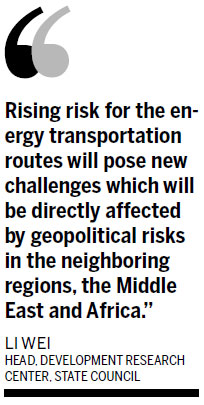China outlines strategy for energy sector
Updated: 2014-02-17 14:12
(China Daily USA)
|
||||||||
New, cleaner sources, industrial transformation needed: Official
China's leading think tank has outlined a revamped energy strategy highlighting new energy and calling for industrial transformation.
In an article entitled "Foreseeing and Analyzing China's Future Energy Development" published by the People's Daily, the flagship newspaper of the Communist Party of China, on Wednesday, Li Wei, head of the Development Research Center of the State Council, said China must transform itself into a country of "security, greenery and efficiency" by 2030 or be faced with erratic supplies and insurmountable environmental challenges.
Li's article is based on two years of research led by the center and supported by more than 70 experts from Royal Dutch Shell Plc, Harvard University in the US and Tsinghua University in China, among others.
The growth of China's energy demand will slow remarkably thanks to the cooling of the economy, but there will be a higher dependency on impact of oil and natural gas.
By 2030, as much as 75 percent of China's oil might be imported. The dependency on overseas natural gas will also rise rapidly, bringing with it grave energy security concerns, Li warned.
Li is a former senior official of the State Council. He put energy security in a wider global context. By 2030, the world's energy supply will be much the same while demand will keep growing, partly because of the industrialization of emerging economies.
There is also a fundamental shift in the world energy supply, with consumption gravitating east and production moving westward.
By 2030, China and India are expected to account for half of the world's oil consumption. The US, on the other hand, will likely be the center for world oil production by 2020 and aims to become the leader in deciding oil and gas prices.
China's energy supply risks might be exacerbated by complicated and volatile geopolitical situations, Li warned.
Despite the US making breakthroughs in energy independence, it is unlikely to soften its grip on oil resources in the Middle East. Reduced dependence on foreign oil will make the US more hawkish in advancing its agenda in the region, making the world's energy market even more unpredictable.
Road ahead
"Rising risk for the energy transportation routes will pose new challenges which will be directly affected by geopolitical risks in the neighboring regions, the Middle East and Africa," he said.
Li also warned of the environmental challenge of increasing fossil fuel consumption. China's oil consumption will keep rising and reach 6 billion metric tons by 2020 and 8 billion metric tons by 2030 if it goes unchecked, putting pressure on the environment.
Li wants a "secure, green and efficient" system of energy production and use.
To secure supplies and avoid a sharp drop in energy self-sufficiency, China should explore new energy and natural gas, while stabilizing domestic oil production and moderately promoting oil made from coal, and the coal chemistry industry.
"Secure and effective" utilization of international resources requires China to set clear strategic goals to limit dependency on foreign oil and natural gas, he urged.
Li called for diversification of oil imports and less dependence on the Middle East as an oil supplier and the Strait of Malacca as a supply route.
Oil firms of oil-producing countries should be encouraged to invest in China's middle and downstream oil business, while Chinese firms should invest abroad in the upper and middle stream business such as refineries.
To increase oil reserves, companies of all kinds should be encouraged to participate in the oil reserve system. Building an oil futures exchange should be accelerated, Li added.

China should also save more energy, he advised.
Total coal use should peak by 2020 and be capped below 3 billion metric tons. Oil consumption should be limited below 550 million metric tons by 2020 and capped at 650 million metric tons by 2030.
The article also set goals for energy efficiency. By 2030, the efficiency rate should reach the "international advanced level" and energy consumption per capita of gross domestic production must be 30 percent lower than the 2020 level.
China should work to cap carbon dioxide emissions from energy consumption below 10 billion metric tons by 2030 - 7 metric tons per person - a similar level to Europe at the same time.
Li highlighted the challenge of urbanization and called for it to be "green" and low-carbon in its implementation.
China's urbanized population could reach 65 percent of its total by 2030, meaning there will be another 300 million people in cities. Per capita urban energy use is normally about three times higher than that in rural areas. An increase of 1 percentage point in the urbanization rate implies increased energy consumption of 60 million metric tons of standard coal.
Urbanization should stick to a "compact city" principle, while the government should clearly define the boundaries of cities to avoid urban sprawl.
Xinhua
(China Daily USA 02/17/2014 page13)

 World's largest freshwater lake frozen
World's largest freshwater lake frozen
 American photographer wins World Press Photo 2013
American photographer wins World Press Photo 2013
 Zhou Yang retains women's 1500m title
Zhou Yang retains women's 1500m title
 Renzi set to become Italy's youngest PM
Renzi set to become Italy's youngest PM
 Kissing contest celebrates Valentine's Day in Beijing
Kissing contest celebrates Valentine's Day in Beijing
 Xinjiang quake damage could have been worse
Xinjiang quake damage could have been worse
 US East Coast buried in snow
US East Coast buried in snow
 China's Li wins women's 500m gold
China's Li wins women's 500m gold
Most Viewed
Editor's Picks

|

|

|

|

|

|
Today's Top News
Dallas shooting kills one, injures six
Venezuela expels 3 US diplomats
High-rise security tightened after stunt
Shelters reveal flaws in child welfare
Precipitation expected to clear up smog-filled skies
Police reveal details of Xinjiang terrorist attack
Canadian immigration changes 'unfair'
Finding real wealth in health industry
US Weekly

|

|




